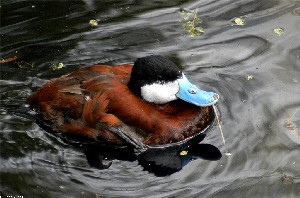 Photograph of Ruddy Duck Courtesy of John White
Photograph of Ruddy Duck Courtesy of John White Typical of river habitat on the Chesapeake Bay, Fairmount WMA's 4,000 acres are mostly marshlands. It is located between the Manokin and Annemessex Rivers in Somerset County. Forested wetlands occupy a small portion of the area. Two man-made ponds, or "impoundments," have been created. This habitat, as well as the lush wetland plants, including wigeongrass, horned pondweed and saltmarsh bulrush and a dense population of invertebrates make Fairmount attractive to many species of waterfowl.
What To See
In the winter, waterfowl fill the impoundments. Black ducks, pintails, gadwall, wigeon, blue- and green-winged teal, and many other species of waterfowl spread across the water, resting and searching for food. In the spring and fall, migrating shorebirds, including glossy ibis and black-necked stilts use the marshes to rest and feed. Visitors often see wood duck hens and their ducklings in and around the water after they have left the many nest boxes made for them by wildlife biologists. Herons and egrets abound, while nesting willets, a type of shorebird, fill the summertime sky.
What To Do
Marshes plus impoundments equal great waterfowl hunting. All the species of ducks mentioned above, as well as Canada geese offer a rewarding hunt during waterfowl seasons. Permits may be required to hunt the impoundments on certain days. Trapping rights are leased yearly. Located on the Chesapeake Bay, Fairmount yields a bountiful harvest of blue crabs. Nature photographers can shoot waterfowl, marshbirds and shorebirds with cameras. Trails through the area and around the impoundments invite hikers and all-terrain bicyclists in for a closer look -- or a closer shot with a zoom lens. Mosquitoes and other biting insects are plentiful from spring through early fall. Bring insect repellent, minimize exposed skin and wear light- colored clothing.
Area Regulations
- Use of Fairmount WMA is generally permitted seven days a week throughout the year.
- Hunting is allowed in accordance with open seasons and shooting hours, unless otherwise noted.
- All State and Federal Hunting Laws and Regulations are applicable.
- Waterfowl hunting in the impoundment has specific regulations including permit requirements for certain days and open and closure dates. For information and permit application click here or call the office listed below.
- Trapping is by permit only.
- No motorized vehicles are allowed.
Special Areas
- Two impoundments, totaling 300 acres, have been created in the tidal wetlands (small jon boat, canoe, kayak, or chest waders are recommended).
Non-hunting Users Guide
- Non-hunting visitors are welcome.
- Be aware of open hunting seasons and visit accordingly.
- Season dates available in newspapers, on the Internet, and at some area stores.
- Trails are maintained and suitable for hiking, nature photography, birding, hunting and other recreational activities, but are not actively marked.
Site Management Goals
- Impoundments have been created and are managed to provide habitat for waterfowl, wading birds, and aquatic mammals.
 Directions
Directions
From U.S. Route 13, take MD 413 south to MD 361 west to Fairmount WMA. Marked parking areas located off Fairmount Road, Lower Hill Road, and Fords Wharf Road. Boat access: via Rumbley, Frenchtown, and Coulbourne Creek public boat ramps. For additional information contact the Wellington WMA at (410) 651-2065.
Fairmount WMA Maps
This area is a part of Maryland’s Department of Natural Resources public land system and is managed by the Wildlife and Heritage Service. The primary mission of the WMA system is to conserve and enhance wildlife populations and their respective habitats as well as to provide public recreational use of the State’s wildlife resources.
Eighty-five percent of the funding for Maryland's state wildlife programs comes from hunting license fees and a federal excise tax on sport hunting devices and ammunition. The federal aid funds are derived from the Federal Aid in Wildlife Restoration (or Pittman-Robertson) Fund, which sportsmen and women have been contributing to since 1937. Each state receives a share of the funds, which is administered by the U. S. Fish and Wildlife Service; these funds are used for wildlife conservation and hunter education programs, including the management of the WMA system.
Other sources of funds for land acquisition include Program Open Space Funding for Maryland's State and local parks and conservation areas, provided through The Department of Natural Resources' Program Open Space. Established in 1969, Program Open Space symbolizes Maryland's long-term commitment to conserving natural resources while providing exceptional outdoor recreation opportunities.